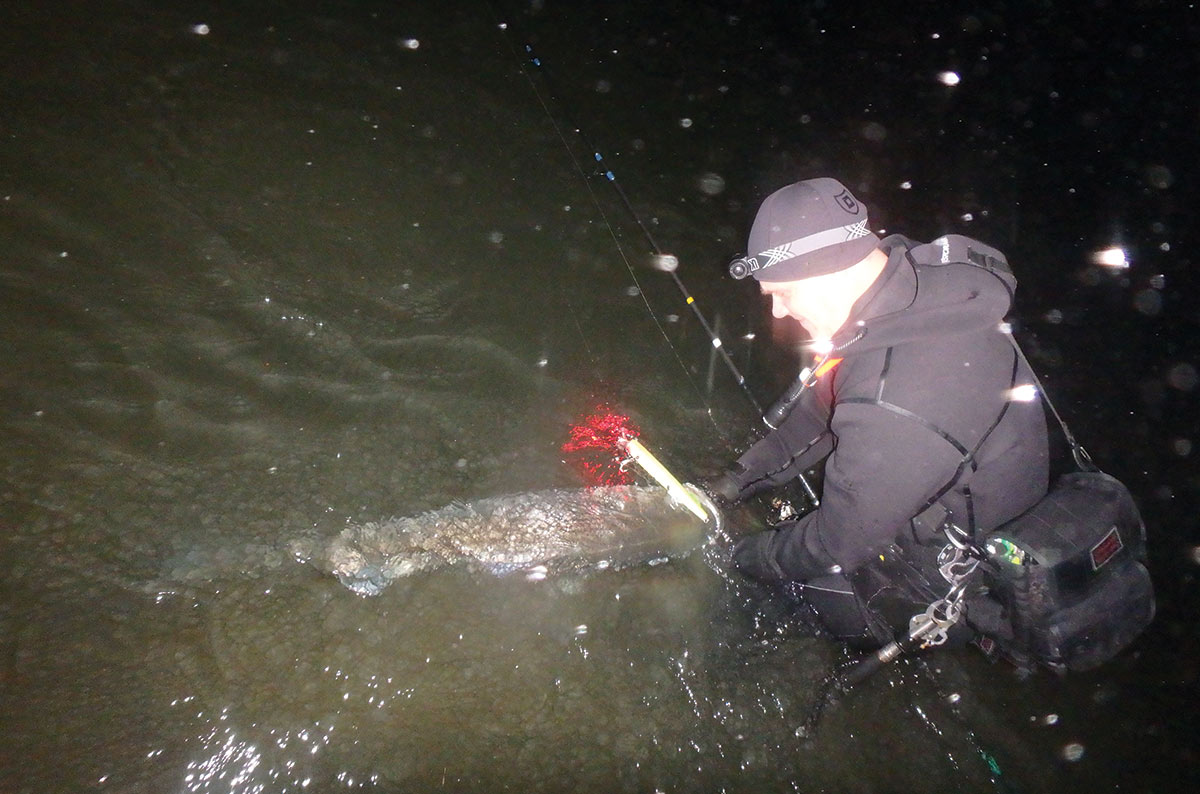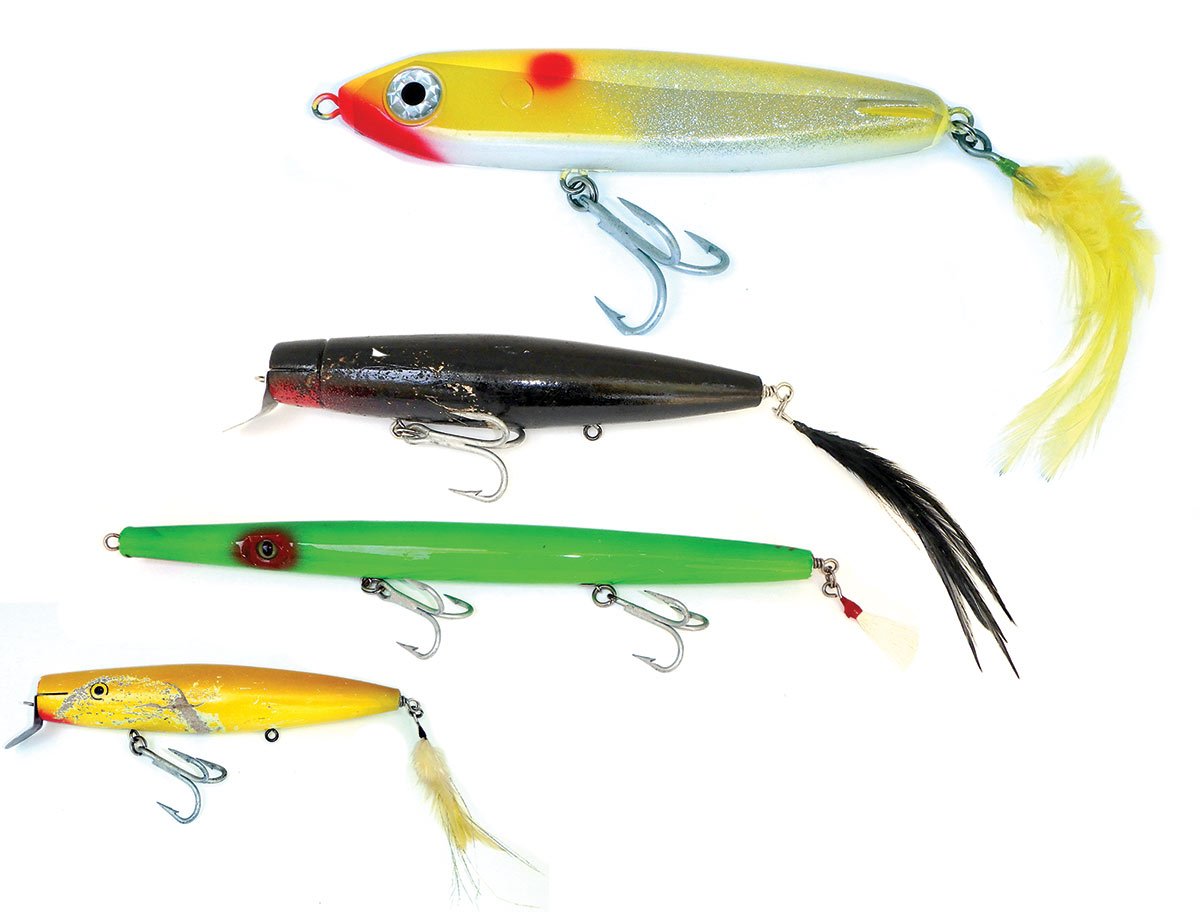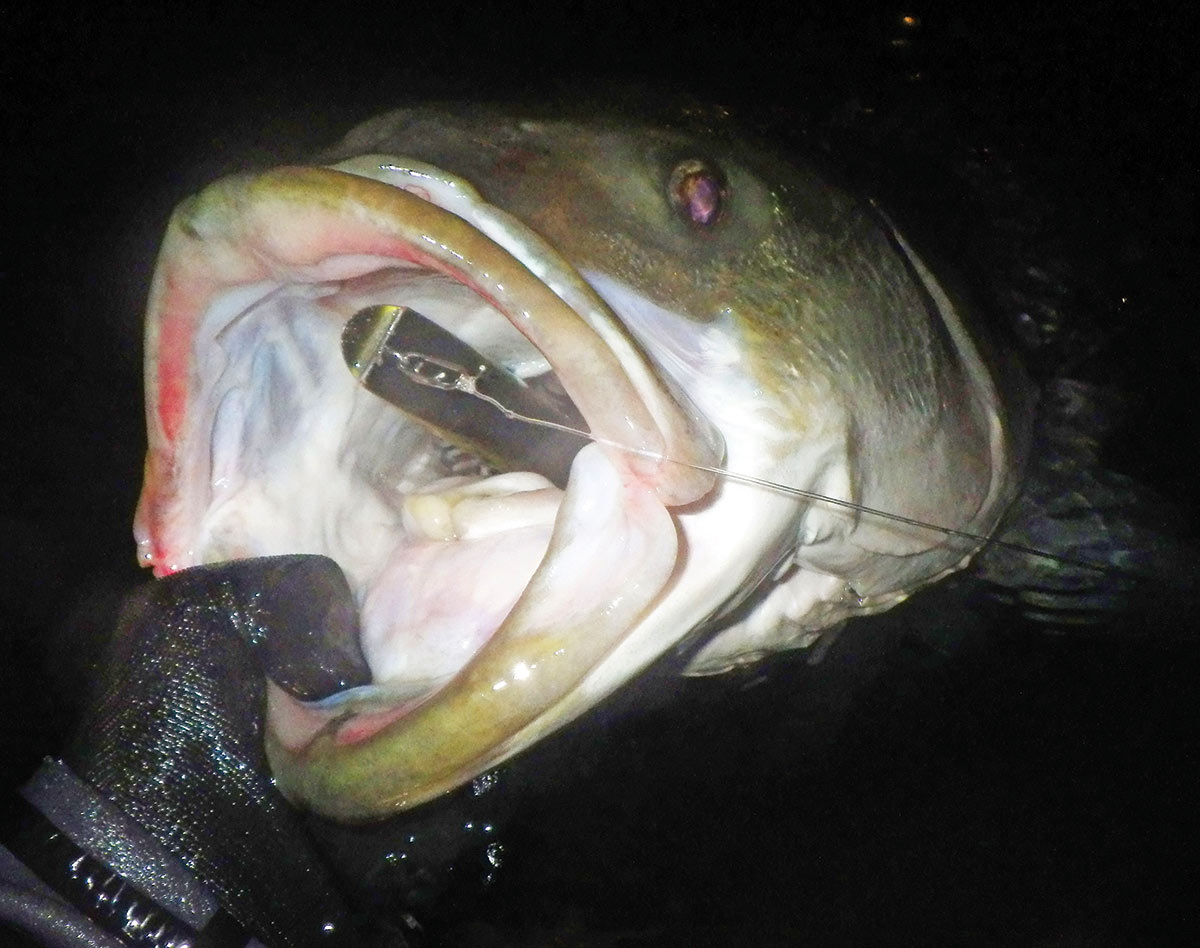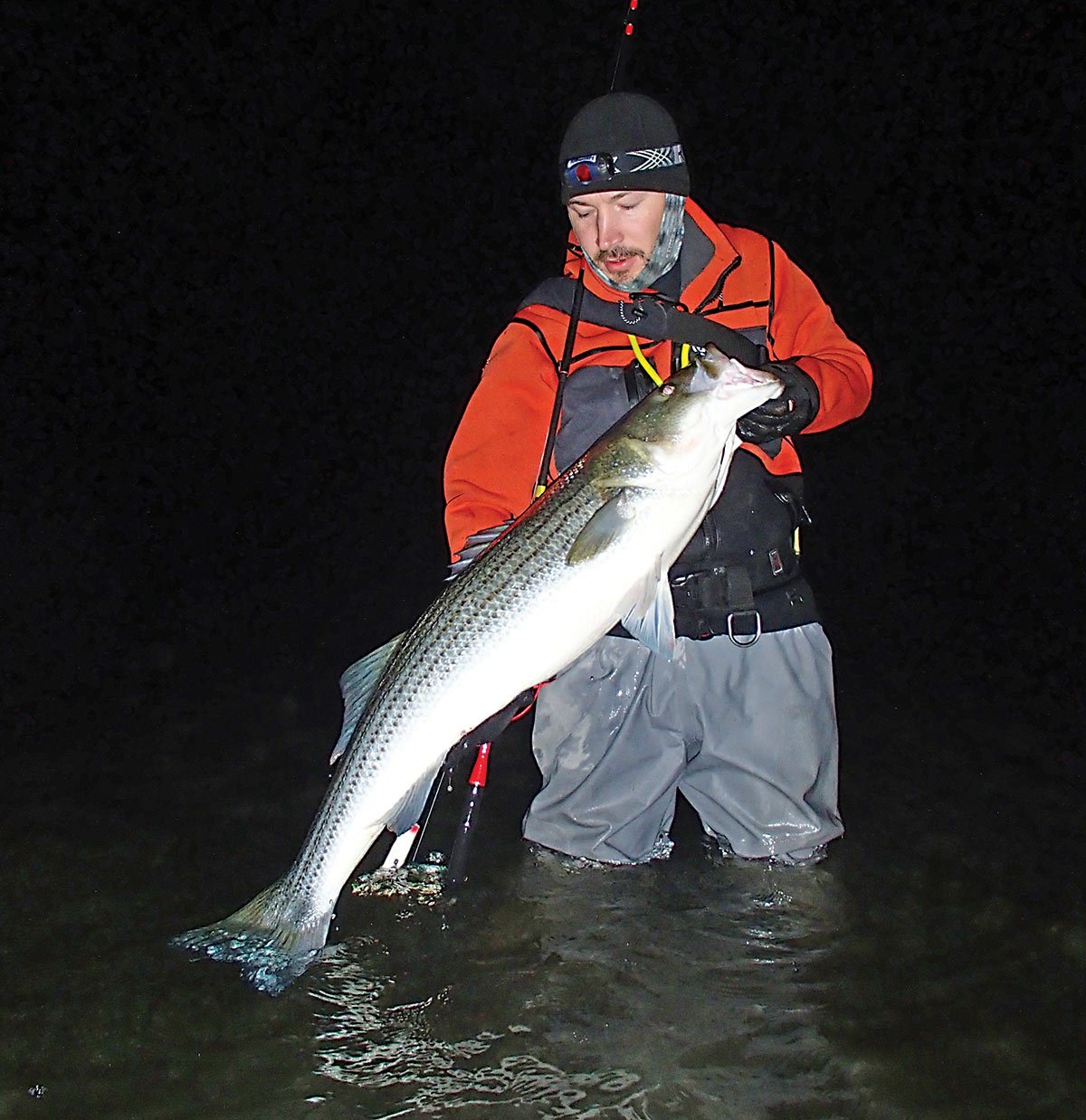
Sometimes you have to “go big” or “go home” when it comes to plugging the surf at night for large striped bass.
Like most of you reading this, I have a seemingly never-ending list of things that have a way of preventing me from fishing as much as I’d like. Between a 5-year-old son, a wife, a dog, a house, a full-time job and all the other fun stuff that comes with being an adult, my only real free time comes long after the sun has set. Luckily for me, this is the best time to hit the surf in search of large striped bass.
I have never been one to commit to only throwing a single thing for an entire season whether it be wood, a certain manufacturer, nothing but bait and so-on. While on the one hand I commend the commitment of certain anglers who have taken on this challenge, I cannot see myself purposely limiting my chances of success in such a way. After all there is an optimum time and place for just about every style of fishing, but conversely there are scenarios wherein it is nothing short of a waste of time to stubbornly stick to one tactic regardless of the reason behind it. While I undoubtedly have favorite ways in which I like to fish, I put likelihood of success at the forefront of my final decision on what to use on a given outing with my end goal being to maximize my results.
For the last several years I have found a rekindled interest in throwing oversized plugs in the surf. From needlefish to metal-lip swimmers, the majority of what I throw on any given night is what many casters would consider large to extra-large plugs. This came about in no small part from the benefit of my fishing partner’s venture into plug building, but it was also born of a noticeable improvement in my success with large striped bass on these larger-than-average offerings. Plain and simple, the average size of the fish that I landed increased proportionately to the size of the lures I threw.
But what constitutes a “big” lure? First up, I am only referring to plugs. This discussion does not include jigs or soft plastics, both of which can be very large in their own right. In the name of simplicity, let’s say that this generalization includes lures of around 3-plus ounces. The top end is really only limited by what your surf rod, back and shoulders can handle. On average I’d say that most of what I throw in the “big bait” category ranges from 4 to 6 ounces, but one or two lures that weigh less than this mark does find its way into rotation as it throws a larger silhouette than its weight affords. Measurements of plugs in this range can vary greatly depending on what type of wood is used, shape of the plug, how much lead is added and so-on. But regardless of final weight or length, this methodology presents a large meal to a predator for a minimal amount of effort expended.

Elephants Do Not Eat Peanuts
First up, let me get this out of the way right off the bat; elephants do not eat peanuts. Will they eat peanuts? Sure, but it is not a favorite or even a preferred food, and it most certainly is not a natural food of theirs. And just to be sure, I Googled it, so it must be true!
Along those same lines I don’t want to hear about the guy you know who landed that one huge bass on a tiny fly that one time some 15 years ago, and I am already well aware of the Massachusetts State Record striped bass landed by Tony Stetzko. In case you are unfamiliar with that story, Tony was fishing the beaches of Nauset on Cape Cod in the fall of 1981. As he was a commercial rod-and-reeler, he was fishing a black teaser fly up ahead of his live eel. The thought here was that with cod known to be in the surf, if his offering passed within sight of a striper then it would take the eel, and if it passed a cod it would take the fly thereby doubling his chances of making some money. Well, as you can guess, Tony hooked and landed a 73-pound striped bass on the night of November 3, and it had the teaser lodged firmly in its mouth with a live eel trailing behind.
But I digress; on average you are simply going to catch smaller fish with small offerings and larger fish with larger ones, and this has been proven time and time again. To further hammer the point home, let me pose this question: If someone offered you $5 for every striper over 50 pounds landed on a fly in a given period of time, versus the same deal for bass landed on a large plug, which would you take? I rest my case.

The Cons
It’s not all roses when throwing big plugs as there are several drawbacks of which one must accept with this tactic. First up your total number of fish landed will noticeably drop once you commit to this type of fishing. I regularly go several outings without so much as a bump, but when I do finally come tight to a fish it is more often than not well worth the wait. I accept that my offering will likely be passed over by many fish along the way before finding success. This takes a certain level of commitment as quite often small fish will try to woo you away from your end goal of going large. But if you really want to succeed with this method, then you must fully commit to it; I can assure you that eventually it will pay off.
Another con with fishing large lures is that the method often takes a toll on both your body and your gear. After a full tide of tossing 4- to 6-ounce plugs I am usually quite sore; I feel it in my back, shoulders, arms and even my legs. This same stress is inflicted on your gear—rod, reel, line, etc.—and can at times be the reason for its failure. If you’re planning to throw 5-ounce plugs with any regularity then you’d better make certain your gear is made for it!

Fishing Big for Big
Before I proceed any further, I feel a need to put out a little disclaimer. Just because you tie on the largest plug you own, it doesn’t mean that you’re going to bail big bass on every cast. You still need to put yourself into a positon to present that lure to the fish that you seek. And then, making it an even more daunting task, when dealing with a specimen that is used to eating such large meals, it might not need to feed for extended periods of time or even on every cycle of the tide. These variables further limit the quantity of fish you’ll land by adopting this approach, but you’ll quickly forget all about the fruitless casts when you hook into a fish that makes you question whether or not you’re throwing heavy enough tackle!
Unfortunately, once you do finally temp one of these rare fish, be prepared to lose more battles than you win. While I feel that it’s a dead giveaway of the googan who publicly laments the loss of a huge fish, plain and simple you are going to lose a lot more big fish than you land. It is simply the nature of the game, but there are things you can do to limit the losses.
First up, while the use of heavy gear is mandatory, you need to know how to properly use it. I am not referring to how to cast and retrieve—you should be well beyond that stage if you’re heading out into the surf at night—but instead how to make that heavy rod, reel, line and leader work to your advantage. You can’t simply hook a 40-pound fish and horse it in; if you take this route then you’re going to lose. You must keep a cool mind and not panic. Let the rod—preferably a slow to moderate action blank—work in your favor. This will not only act as a cushion to prevent hooks from being pulled and tackle from breaking, but the flex afforded by a more moderate action blank will tire out a fish faster than a fast action rod. It also puts less stress on your body, allowing you battle than the fish.
Your drag should not be locked too tight, but conversely it should not be too loose either. There is a happy medium, and I generally err on the side of a slightly lighter setting. I can always add some finger pressure to the spool when a fish takes a long run or makes a B-Line for a snag, but I can’t so quickly back off the drag when set too tight. A tight drag is really only beneficial to get a good hookset, and then during the fight it only helps in a last-ditch effort to prevent a fish from reaching a point of no return like wrapping around an exposed rock or running into a field of lobster buoys. For as long as the conditions allow, let your drag just hold the fish back from having its way with you so that you can tire it out and make landing the fish that much easier (and safer). You can still quite easily gain line on a fish with a lighter drag setting by reeling down on the fish, lifting up on the rod (while adding a touch of pressure to the spool with your finger) and then reeling down again in succession until the fish is at your feet.












